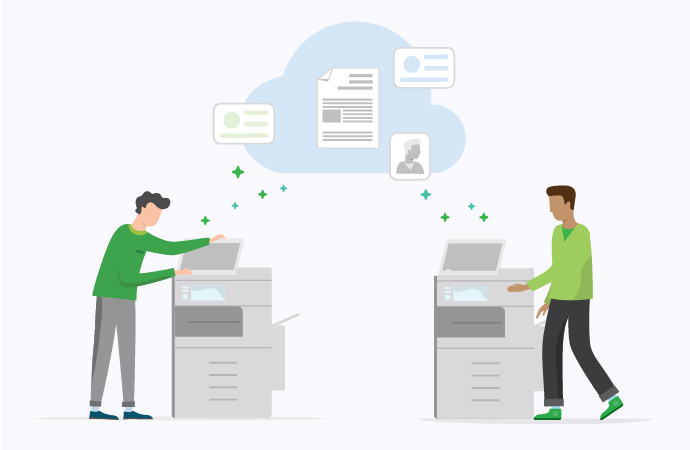We went to the moon in the 60s, the cloud shouldn’t be that hard!
More and more offices around the world are increasing productivity by storing their documents in the cloud , allowing for wider collaboration on all devices, regardless of where users are. Still, it’s hard to break our reliance on physical paper.
“A paperless office is a smart and prudent goal for businesses to have, but it’s a lofty one," wrote CEO and author, Heinan Landa.
“We have a ways to go before we get anywhere close to going truly paperless. In the same way that older generations aren’t ready to give up their Blackberry or their Rolodex, those in the workforce today just aren’t ready to give up paper.”
At PaperCut, we’re always looking for ways to improve cloud integration (and paper saving), and one of the biggest time-savers is Scan to Cloud Storage. It’s a scan function that allows PaperCut users to authorize credentials once, right at the start, then scan documents direct to their cloud services provider.
This gives you controlled access for jobs leaving your network, and it doesn’t matter what brand, make or model MFD you have.
PaperCut’s embedded solution lets your admin choose from most cloud providers including Google Drive, GSuite, Dropbox, SharePoint, Microsoft OneDrive, Box, Evernote, and pCloud.
So how do Scan to Cloud and scan storage work in practice? Let’s dive in and find out.
What is Scan to Cloud?
Scan to Cloud is simply a way to automate scanning and cloud-based document storage. Let’s look at an example. At PaperCut, we used this tech to help a large chain of real estate agents.
These agencies used Microsoft Sharepoint Online to store and manage most of their business data. The problem was, every week they needed to submit invoices from cleaners, vendors, trades and other sources for approval and payment. Doing this manually was a bit of a nightmare.
With Scan to Cloud, however, a branch member could pile up the week’s invoices and – using a single scan action – process hundreds of pages at once.
Each invoice became an individual, text-searchable PDF with OCR, and was automatically loaded into the appropriate OneDrive folder. With a file name that identified the branch it came from. Not too shabby, right?
What are the benefits of Scan to Cloud?
A cloud document scanner is one of the best ways to cut down on manual labor at the MFD. Instead of standing there scanning individual documents, saving and labeling each one, then loading them into the appropriate cloud folder, you can automate the entire process. Here are some other perks of Scan to Cloud.
Authentication flow
PaperCut provides a cloud-hosted broker service to deliver a user’s scans to their chosen cloud storage provider.
The first time you scan to an approved cloud storage provider (‘approved’ is at the discretion of the system admin), our broker service will email you, asking for authorization to access the provider on your behalf.
You just click the link in the email to grant the access! No more entering email addresses and complex passwords on screens at the MFD.
Encrypted transfer
Scan jobs are encrypted every step of the way.
The scan is sent from the MFD to your PaperCut MF server. Encrypted and secure. Then from your PaperCut MF server to our broker server. Encrypted and secure. Finally, from our broker server to the cloud storage provider.
Again, encrypted and secure. Every interaction of the process uses the most modern encryption and security practices. As a sweetener for your network admin, there’s only one path out from your network for these cloud services.
Who doesn’t love a simple firewall rule?
Reliable connections
Everyone has experienced that frustration of making a disproportionate amount of clicks to start a scan. Entering an email address using a tiny keyboard, prone to errors. Feeling like they’ve completed the technical equivalent of climbing Everest to get that scan to actually send… only to find out there was a send error.
When a user starts Scan to Cloud with the PaperCut MF embedded app, there are built-in retries for every step (to reduce the chance of users having to start the whole process all over again). And everything starts with a single click.
Cloud storage providers
Scan to Cloud works with all the cloud supporters you recognize, and even some you probably don’t. We’ve deliberately supported as many platforms as possible, and we’re constantly adding more to the mix.
Since we add these providers to our broker service, embedded solutions connected to an up-to-date PaperCut MF server will instantly access these new services too. There’s no need to add a new one for each MFD. No firmware rollout for each MFD. It’s the simplest addition of new services going around.
HIPAA compliance
If you’re worried about HIPAA compliance, don’t be. Scan to Cloud is secure and fully compatible. In fact, PaperCut will help your organization with HIPAA compliance around printing and scanning.
No longer do you have to worry about patient health information (PHI) misuse, or documents sitting around unsecured. PaperCut uses HIPAA-compliant technology when sending data to your preferred cloud storage provider.
How to get started with scan storage
Scan to Cloud Storage is part of PaperCut MF ’s embedded solution, and we can help you configure it to suit your business. It’s actually quite easy to set up the appropriate protocols and approval steps.
You can also read more about Scan to Cloud on our blog . To get started with Scan to Cloud, speak to our team.

Speak with Sales
Need a little help from a human? Speak with us, we don’t bite.
By filling out and submitting this form, you agree that you have read our Privacy Policy, and agree to PaperCut handling your data in accordance with its terms.
This site is protected by reCAPTCHA and the Google Privacy Policy and Terms of Service apply.




